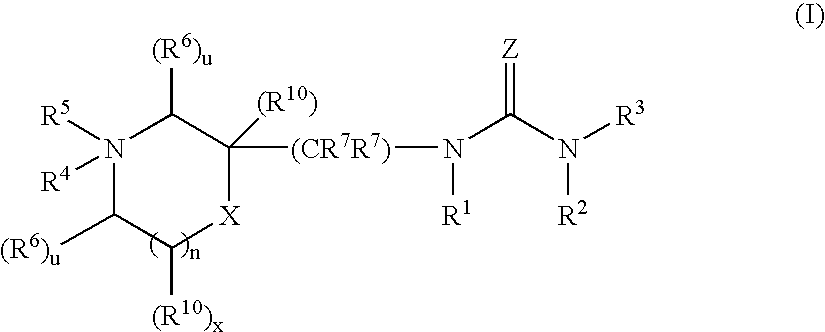N-substituted heterocyclic amines as modulators of chemokine receptor activity
a technology heterocyclic amine, which is applied in the field of modulators of chemokine receptor activity, can solve the problems of not being disclosed nor suggested in the prior ar
- Summary
- Abstract
- Description
- Claims
- Application Information
AI Technical Summary
Benefits of technology
Problems solved by technology
Method used
Image
Examples
example 1
Part A: Preparation of 3-hydroxymethylpiperidine-1-carboxylic acid tert-butyl ester
[0276]A solution of piperidin-3-ylmethanol (25.0 g, 217 mmol) in 1,4-dioxane (500 mL) was stirred at room temperature and treated sequentially with triethylamine (30.3 mL, 217 mmol) and a solution of di-tert-butyl dicarbonate (47.3 g, 217 mmol) in 1,4-dioxane (60 mL). The reaction was stirred at room temperature for 18.5 hours, then was concentrated under vacuum to provide the title product as a white solid containing traces of 1,4-dioxane (47.08 g, quantitative), which was used without purification. 1H NMR (300 MHz, CDCl3) δ3.76 (m, 2H), 3.65 (m, 2H), 3.52 (d, J=7 Hz, 2H), 2.00 (b, 1H), 1.78 (m, 2H), 1.66 (m, 1H), 1.47 (s, 9H), 1.29 (m, 1H).
Part B: Preparation of 3-methanesulfonyloxymethyl-piperidine-1-carboxylic acid tert-butyl ester
[0277]A solution of 3-hydroxymethylpiperidine-1-carboxylic acid tert-butyl ester (15.0 g, 69.7 mmol) and triethylamine (14.6 mL, 104.5 mmol) in dichloromethane (270 mL) ...
example 2
Part A: Preparation of 3-(4-fluorophenyl)-propan-1-ol
[0290]A solution of 3-(4-fluorophenyl)-propionic acid (4.20 g, 25 mmol) in tetrahydrofuran (10 mL) was stirred on an ice bath and treated with a solution of borane in tetrahydrofuran (1.0 M, 33 mL, 33 mmol) over 15 minutes. The resulting solution was stirred at room temperature for one hour. A mixture of tetrahydrofuran (5 mL) and water (5 mL) was added over 2 minutes. After 5 minutes of additional stirring, 4 mL of additional water was added, and solid potassium carbonate was added until the aqueous phase was saturated. The layers were separated and the aqueous phase was extracted three times with ethyl acetate. The combined organic phases were dried over sodium sulfate and concentrated to provide a colorless liquid (3.70 g, 96%) which was used without further purification. 1H NMR (300 MHz, CDCl3) δ7.16 (m, 2H), 6.99 (t, J=9 Hz, 2H), 3.69 (t, J=6 Hz, 2H), 2.70 (t, J=8 Hz, 2H), 1.87 (m, 2H), 1.50 (bs, 1H). Mass spec (CH4-CI) m / z 1...
example 3
Part A: Preparation of 2-(4-trifluoromethylphenyl)-ethanol
[0293]A solution of 4-trifluoromethylphenylacetic acid (784 mg, 3.84 mmol) in tetrahydrofuran (3 mL) was cooled to 0° C. and treated dropwise with a solution of borane in tetrahydrofuran (1.0 M, 5.4 mL, 5.4 mmol). The mixture was stirred at room temperature for 2.75 hours, then was treated slowly with 50% water in tetrahydrofuran (2 mL), followed by water (2 mL). The mixture was stirred for 5 minutes, and solid potassium carbonate was added to saturate the aqueous phase. The layers were separated and the aqueous phase was extracted with ethyl acetate. The combined organic phases were dried over sodium sulfate and concentrated under vacuum to provide a colorless liquid (585 mg, 80%) which was used without further purification. 1H NMR (300 MHz, CDCl3) δ7.59 (d, J=8 Hz, 2H), 7.38 (d, J=8 Hz, 2H), 3.92 (t, J=7 Hz, 2H), 2.95 (t, J=7 Hz, 2H), 1.53 (s, 1H).
Part B. Preparation of toluene-4-sulfonic acid 2-(4-trifluoromethylphenyl)-et...
PUM
| Property | Measurement | Unit |
|---|---|---|
| molecular weight | aaaaa | aaaaa |
| boiling point | aaaaa | aaaaa |
| pressure | aaaaa | aaaaa |
Abstract
Description
Claims
Application Information
 Login to View More
Login to View More - R&D
- Intellectual Property
- Life Sciences
- Materials
- Tech Scout
- Unparalleled Data Quality
- Higher Quality Content
- 60% Fewer Hallucinations
Browse by: Latest US Patents, China's latest patents, Technical Efficacy Thesaurus, Application Domain, Technology Topic, Popular Technical Reports.
© 2025 PatSnap. All rights reserved.Legal|Privacy policy|Modern Slavery Act Transparency Statement|Sitemap|About US| Contact US: help@patsnap.com



